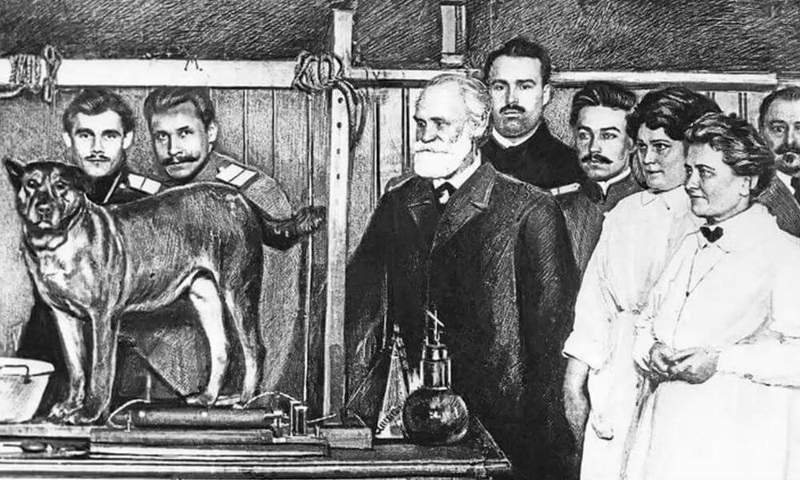Pávlov dog experiment What were your findings?

- 3317
- 633
- Glen Vandervort Sr.
Pávlov's dog experiment is one of the most famous experimental studies in the history of psychology. Thanks to his works, Iván Pávlov laid the foundations for a new way of understanding human and animal behavior: behaviorism. His research revealed to the scientific community that behavior could be studied in an objective way, measuring and manipulating variables.
The above was a radical change in an era where paradigms such as psychoanalysis dominated. Today, Pávlov studies remain an important influence within the works of modern behaviorists. For that reason, it is essential to know more about his famous experiment and the findings that arose from there.
Content
Toggle- Who was Iván Pávlov?
- Pávlov's dog experiment
- How was the experiment?
- What were the findings of the Pávlov dog experiment?
- Implications of the Pávlov Dog Experiment
- References
Who was Iván Pávlov?
Iván Pávlov was a Russian physiologist born in Riazán on September 14, 1849. Because he was born within a religious family, he was expected to be dedicated to theology. In fact, his father, Piotrievich Pávlov, was a priest of the Russian Orthodox Church. However, from a young age, Pávlov showed more interest in science and when he grew up he began his studies in Chemistry and Medicine. In 1883, he got his doctorate and a short time later he traveled to Germany to specialize in intestinal physiology.
Following this line, in 1904, Pávlov won the Nobel Prize in Physiology thanks to his work on gastric surgery. The physiologist was the first of Russian origin to get the award. In addition to that, the scientist became famous worldwide for his formulation of the conditional reflection law. To get to this theory, the Pávlov Dog experiment was developed that we will know below.
Pávlov's dog experiment
At first, Pávlov was only evaluating the physiological response of dogs to food. To this end, he placed food in the mouth of the animals and observed that a salivation response occurred immediately. Thus, he decided to call this Salivation reflex Because it happened automatically.
After repeating the procedure several times, he realized that the animal salivated with only its presence, without there being food. Pávlov inferred that, due to some psychological mechanism, the salivation reflection was activated, although the food was not present. His initial hypothesis was CAN learned to associate the appearance of the scientist with food. In this way, the famous experiment of Pávlov dogs began to be designed.
Classic conditioning vs operant conditioning
How was the experiment?
With the aim of checking his ideas, Pávlov prepared an experiment to evaluate the salivation reflex in dogs. For this, he used a metronome (an instrument used by musicians to mark the rhythm) that sounded just before feeding the animal. After several repetitions of the same trial, Pávlov sounded the metronome without presenting the food to the dog. In this way, he discovered that the salivation reflection occurred even without this being.
The above verified the initial hypothesis of the scientist, somehow, the stimuli presented ended up associated with food. In 1903, the researcher presented the results of his work at the14th International Medical Congress in Madrid. There, he presented his findings with the title of The Experimental Psychology and Psychopathology of Animals.
 Watson and Classic Conditioning
Watson and Classic Conditioning What were the findings of the Pávlov dog experiment?
The Pávlov dog experiment served to define the law of conditional reflex. In simple terms, This theory proposes that a neutral stimulus can produce a reflex or unconditional response if associated with an unconditioned stimulus.
For example, in the case of the experiment with dogs, the unconditioned stimulus (EI) would be food. This stimulus would produce the salivation unconditioned response (RI). Both receive the denomination of unconditioned because they occur without any intervention. Then, we have the metronome sound, this would be our neutral stimulus (in). In the experiment, Pávlov presents the one with the IS in several essays.
After some repetitions, the animal's brain performs an association between both stimuli. Now, the en is capable of producing the IR and becomes a conditioned stimulus (EC) and the reflection in a conditioned response (RC).
Implications of the Pávlov Dog Experiment
Pávlov's dog experiment was not only useful for studying animal behavior, but also the human. An example of this is the controversial experiment of little Albert made by John B. Watson and Rosalie Rayner. Based on the theory of conditional reflex law, researchers wanted to demonstrate that phobias arose from learning.
To check it, the scientists chose a 9 -month healthy baby and verified that they did not have a fear prior to hairy animals. He presented monkeys, rabbits, dogs and even a rat, before which the child did not show fear reactions. In turn, they saw that the child was afraid of strong noise (such as the blow of a hammer on a metal sheet).
Then, they began to present a white rat, while Watson hit a metal bar behind the child's head. After several essays, the child began to have fear and crying reactions in the presence of the animal (which did not happen before). But, fear was not limited to rats, the child began to show phobia to any similar stimulus. For example, I could start crying in the presence of a white hair coat or a dog.
In conclusion, the experiment of Pávlov dogs revolutionized the understanding of human behavior. Thanks to his works, he began the development of an experimental psychology, based on essays that showed reliable data.
References
- Borrás, f. X. (1994). Classic conditioning of immune responses. Magazine of General and Applied Psychology: Magazine of the Spanish Federation of Psychology Associations, 47(4), 429-439.
- Pavlov, i. P. (2020). Experimental psychology and psychopathology in animals. In Psychopathology and Psychiatry (pp. 13-30). Routledge.
- Laziness. M., & Cruz, J. AND. (2003). Concepts of classical conditioning in the basic and applied fields. Interdisciplinary, twenty(2), 205-227.

